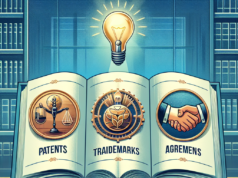
In an era marked by rapid technological advancements and globalization, intellectual property (IP) law is undergoing revolutionary changes that are reshaping the landscape for creators, businesses, and consumers alike. As the digital age continues to evolve, so too must the legal frameworks that protect intellectual property rights. This article delves into the significant transformations in IP law, highlighting key legislative changes, the influence of technology, global perspectives, and the challenges and opportunities that lie ahead for businesses navigating this new terrain.
Understanding the Evolution of Intellectual Property Law in the 21st Century
The 21st century has witnessed a profound evolution in intellectual property law, driven by the convergence of technology, creativity, and commerce. Historically, IP law was designed to protect the rights of creators and inventors, ensuring they could reap the benefits of their innovations. However, the rise of the internet, digital media, and global commerce has necessitated a reevaluation of existing laws. The traditional frameworks, which often lagged behind technological advancements, are now being reformed to address issues such as digital piracy, online copyright infringement, and the complexities of global trade. As a result, IP law is becoming more dynamic, adaptable, and responsive to the needs of a rapidly changing world.
Key Legislative Changes Impacting Copyright, Patents, and Trademarks
Recent legislative changes have significantly impacted the realms of copyright, patents, and trademarks. In the United States, the Music Modernization Act and the Copyright Alternative in Small-Claims Enforcement (CASE) Act have introduced new mechanisms for copyright protection and enforcement, particularly in the digital space. Similarly, the European Union’s Digital Single Market Directive aims to harmonize copyright laws across member states, enhancing protections for creators while facilitating access to content for consumers. In the realm of patents, the introduction of the America Invents Act has shifted the U.S. patent system from a “first to invent” to a “first to file” approach, streamlining the patent application process. These legislative changes reflect a broader trend towards modernizing IP laws to better serve the interests of both creators and consumers in an increasingly interconnected world.
The Role of Technology in Shaping Modern Intellectual Property Regulations
Technology plays a pivotal role in shaping modern intellectual property regulations, as it both challenges existing frameworks and offers innovative solutions for enforcement and compliance. The rise of artificial intelligence (AI), blockchain, and big data analytics has introduced new complexities in IP law, particularly concerning ownership, attribution, and the protection of digital assets. For instance, AI-generated works raise questions about authorship and copyright eligibility, while blockchain technology offers potential solutions for tracking ownership and provenance of creative works. Additionally, advancements in data analytics are enabling more effective monitoring of IP infringements, allowing rights holders to respond swiftly to violations. As technology continues to evolve, IP regulations must adapt to address these emerging challenges and leverage new tools for protection and enforcement.
Global Perspectives: How Different Countries Approach IP Law Reforms
The approach to intellectual property law reforms varies significantly across different countries, reflecting diverse legal traditions, economic priorities, and cultural values. In the United States, the focus has been on enhancing protections for digital content creators, while in Europe, the emphasis has been on balancing the rights of creators with the need for consumer access to information. In contrast, developing countries often grapple with the challenge of fostering innovation while ensuring that IP laws do not stifle access to essential goods and services. For instance, countries like India and Brazil have adopted more flexible IP frameworks to promote local innovation and access to medicines. As globalization continues to blur national boundaries, international cooperation and harmonization of IP laws will be crucial in addressing the challenges posed by differing legal regimes.
Challenges and Opportunities for Businesses in the New IP Landscape
As the intellectual property landscape evolves, businesses face both challenges and opportunities in navigating the new regulatory environment. One of the primary challenges is the increased complexity of compliance, as companies must stay abreast of rapidly changing laws and regulations across multiple jurisdictions. Additionally, the rise of digital platforms has made it easier for IP infringement to occur, necessitating robust enforcement strategies. However, these challenges also present opportunities for businesses to innovate and differentiate themselves in the marketplace. By leveraging new technologies for IP management and protection, companies can enhance their competitive advantage and foster a culture of creativity and innovation. Furthermore, businesses that proactively engage in IP education and advocacy can help shape the future of IP law to better align with their interests and the needs of their stakeholders.
Future Trends: What to Expect in Intellectual Property Law Over the Next Decade
Looking ahead, several key trends are likely to shape the future of intellectual property law over the next decade. First, the ongoing integration of technology into IP frameworks will continue to drive reforms, particularly in areas such as AI, data privacy, and digital rights management. Second, as the global economy becomes increasingly interconnected, there will be a growing emphasis on international cooperation and harmonization of IP laws to address cross-border challenges. Third, the rise of sustainability and social responsibility will influence IP law, as businesses and policymakers seek to balance innovation with ethical considerations. Finally, the increasing importance of consumer rights and access to information will prompt ongoing debates about the appropriate balance between protecting creators and ensuring public access to knowledge and culture. As these trends unfold, stakeholders across the IP landscape must remain vigilant and adaptable to navigate the complexities of the evolving legal environment.
In conclusion, the revolutionary changes in intellectual property law reflect the dynamic interplay between technology, creativity, and commerce in the 21st century. As legislative reforms, technological advancements, and global perspectives continue to shape the IP landscape, businesses and creators must stay informed and proactive in adapting to these changes. By understanding the challenges and opportunities presented by the new IP environment, stakeholders can better position themselves for success in an increasingly competitive and interconnected world. The future of intellectual property law promises to be both complex and exciting, requiring ongoing engagement and collaboration among all parties involved.



























